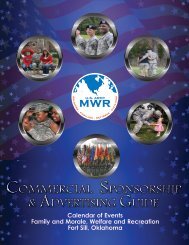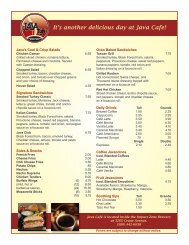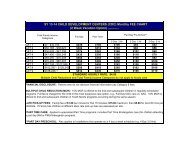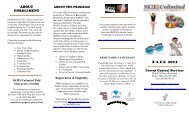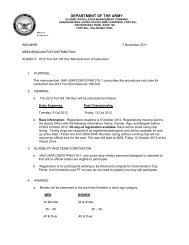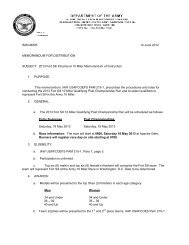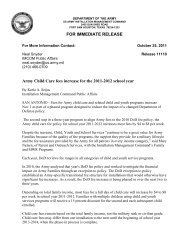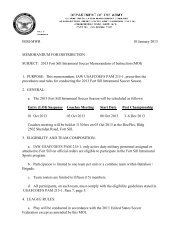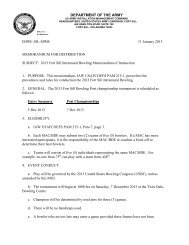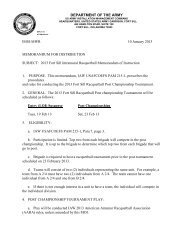Preparing and Managing Correspondence - Fort Sill MWR
Preparing and Managing Correspondence - Fort Sill MWR
Preparing and Managing Correspondence - Fort Sill MWR
You also want an ePaper? Increase the reach of your titles
YUMPU automatically turns print PDFs into web optimized ePapers that Google loves.
. Dates on letters. Express dates on letters <strong>and</strong> refer to dates within letters only in this way: January 1, 2000.<br />
c. Separating date elements. Avoid separating any of the three date elements (day, month, <strong>and</strong> year) from each<br />
other, but if it is absolutely necessary, the four-digit year may be carried over to the next line when the month is<br />
spelled out.<br />
1–28. Expressing time<br />
Military time will be expressed in a group of four digits, ranging from 0001 to 2400 based on the 24-hour clock<br />
system. The first two digits represent the hour after midnight <strong>and</strong> the last two digits represent the minutes. For<br />
example, 1:37 p.m. civilian time is expressed as 1337 military time. The word hours will not be used in conjunction<br />
with military time. Use civilian time in letters.<br />
1–29. Suspense date<br />
a. Use a suspense date on memor<strong>and</strong>ums when a reply is required by a certain date. (See fig 2–2.) Suspense dates<br />
should be reflected in the body text <strong>and</strong> appear in bold. Do not use suspense dates on letters.<br />
b. Consider the following time factors in setting a suspense date on correspondence:<br />
(1) Number of days required to transmit the communications.<br />
(2) Number of days needed to complete the action.<br />
(3) Number of days required to transmit the reply.<br />
1–30. Addressing<br />
Address correspondence <strong>and</strong> envelopes as prescribed in AR 25–51, Official Mail <strong>and</strong> Distribution Management, <strong>and</strong><br />
chapter 5 of this regulation.<br />
1–31. References<br />
List references in the first paragraph of the correspondence. Enclose copies of references that are not readily available<br />
to the addressee. List <strong>and</strong> number references in the order they appear in the correspondence. When references do not<br />
appear in the text of the correspondence, list them in ascending date order (oldest to most recent). Include the<br />
following information as a minimum:<br />
a. Publications. When listing publications, include the number, title, <strong>and</strong> date, for example, AR 25–50, <strong>Preparing</strong><br />
<strong>and</strong> <strong>Managing</strong> <strong>Correspondence</strong>, 21 Nov 88; <strong>and</strong> (for a supplement <strong>and</strong> change) USASC, Suppl 1, 3 Mar 95, to AR<br />
710–2, Inventory Management Supply Policy Below the Wholesale Level, 31 Oct 97; <strong>and</strong> Change 2, 15 Oct 99, to DA<br />
Pam 27–9, Military Judges’ Benchbook, 30 Sep 96.<br />
b. <strong>Correspondence</strong>. When referencing correspondence, include the type of correspondence, organization of origin,<br />
office symbol, date, <strong>and</strong> the subject of the correspondence, for example, Memor<strong>and</strong>um, HQ USAMC, AMCIO–F, 20<br />
Feb 88, subject: Training for AMC Personnel; <strong>and</strong> Message, HQ TRADOC, ATPL–TD–OR, 101623Z Sep 84, subject:<br />
<strong>Correspondence</strong> Management. When referencing e-mail or facsimiles, use the name of the sender <strong>and</strong> the office symbol<br />
(if included), for example, E-mail, HQ TRADOC (ATPL–TD–OR), Mr. Sam Jones, 3 Nov 96, subject: <strong>Correspondence</strong><br />
Management; <strong>and</strong> Fax, HQ FORSCOM, Ms. Ella Johns, 25 Feb 97, subject: Copier Management.<br />
c. Referencing classified or unclassified material. (See chap 8 for portion marking.) Use the following guidelines<br />
when referencing unclassified material in a classified document or referencing classified material in a classified or<br />
unclassified document.<br />
Note. When the reference contains classified information or is required to be placed within a classified document, portion-mark the<br />
reference <strong>and</strong> the subject of the reference with the appropriate classification symbol. See AR 380–5 for guidance.<br />
(1) When referencing a classified document in unclassified correspondance, show the classification of both the<br />
referenced material <strong>and</strong> the subjuct, for example, Secret message, HQ TRADOC, ATCG, 201623Z Sep 94, subject:<br />
<strong>Correspondence</strong> Management (U).<br />
(2) When referencing unclassified correspondence in a classified document, show the classification of the referenced<br />
material <strong>and</strong> the subject, for example, (U) Unclas message, HQ TRADOC, ATPL–TD–OR, 201623Z Sep 84, subject:<br />
<strong>Correspondence</strong> Management (U).<br />
(3) When referencing a classified document that has a classified subject in classified correspondence, show the<br />
classification of both the reference <strong>and</strong> its subject, for example, (C) Secret message, HQ TRADOC, ATCG, 201623Z<br />
Sep 94, subject: <strong>Correspondence</strong> Management (C).<br />
(4) When drafting an unclassified document <strong>and</strong> the subject of the reference(s) is classified, the document must<br />
show the classification assigned to the referenced subject. The document then becomes classified to the level of the<br />
reference cited <strong>and</strong> must be marked appropriately. (See AR 380–5 <strong>and</strong> chap 8 for proper marking of classified<br />
correspondence.)<br />
(5) When drafting an unclassified piece of correspondence that contains a mixture of classified <strong>and</strong> unclassified<br />
references although all subjects are unclassified, show the classification marking for each reference. Here are examples<br />
of references:<br />
AR 25–50 • 3 June 2002<br />
5




